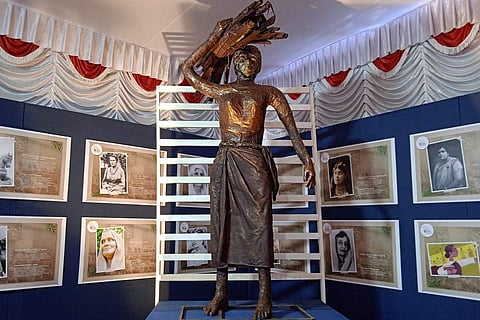

Barring the instrumental film music that plays in the background, the condensed exhibition of women’s struggles, beginning from world history and tapering to corners of Kerala, is smartly curated. At the Ayyankali Hall in Thiruvananthapuram, the exhibition of pictures and life-size sculptures spread out in two large rooms begin with the big and popular women’s movements across the world and slip into the lesser known stories of women who fought for rights and freedoms.
In its description of the ‘Drishya Bhoomika’ exhibition, the All India Democratic Women’s Association (AIDWA) – holding it as part of its national conference – says that the role of women in shaping modern history was made invisible by dominant ruling classes, administrators and academics who tended to take a male, dominant, patriarchal position. The exhibition is an attempt to bring out those stories which are left out by historians.
“They are the women who fell in the gutters of history,” says AG Oleena, director of the State Literacy Mission and coordinator of the exhibition. Attempts are being made by several groups to fill these gaps in history, she says. “At the same time that Jhansi Rani fought for India, we had Mahabiri Devi, a Dalit woman [from Muzaffarnagar in UP] who fought the British. But the latter’s story is little celebrated. We need to include the stories of all these women for history to be complete, not that history ever can be.”
They don’t leave out the popular names, the celebrated events. There is the painting of ‘Liberty leading the people’ during the French Revolution, sculptures of the first women's rights convention, and the iconic photos of the Suffragist movement. After covering the struggles through the ages — from the first Women’s Day of 1911 to the anti-abortion protests of recent times — a painting exhibition quietly takes you to the stories of women in Kerala; the legend of Nangeli, who mythically cut her breasts in protest against the breast tax, prominent among them. Real stories of maaru marakkal samaram (protest by women of oppressed castes to cover their upper bodies) and the historical entry of a Dalit girl called Panchami into a school, holding the hands of social reformer Ayyankali, follow.
Scattered among the more popular names are the lesser known ones of women in Kerala who fought for rights and freedoms. From the exhibition on women's struggles in Thiruvananthapuram's Ayyankali Hall. pic.twitter.com/VykXHXeYeW
— Cris (@cristweets) January 9, 2023
In the second room, divided into sections, photos and short descriptions of women across the country who rebelled against the patriarchal norms and took part in freedom movements tell a story of India you don’t often hear about. “In matters of leaving names, there has always been practice of dropping out the names of women, in any discourse,” Oleena says. The exhibition is an attempt in retrieving those names, she adds.
Scattered among the more known names of the Indian Independence movement like Bhikaji Rustom Cama, Annie Besant and Annie Mascarene, are the less heard stories of MK Paru, Kurumba and M Haleema Beevi.
When women of certain castes won the rights to wear jewellery
When Mahatma Gandhi led the salt satyagraha, MK Paru, along with her mates walked to the Payyannur beach, collected sea-water, came back home and made salt to join the protest against the British salt laws. Kurumba, in 1946, took part in the fight for rights of members of the oppressed castes to walk through the paths in front of the Kudalmanikyam temple, where the dominant caste people drew boundaries at Kootamkulam. Kurumba suffered from injuries that she received that day for several years.
M Haleema Beevi did get belated recognition, on being the first Muslim woman journalist from the state, who founded the Muslim Vanitha magazine in 1938. But she had to shut it down several months later after conservationists took issue with it. Undeterred, she began more magazines, all with the aim of bringing women to the fore.
Haleema Beevi (bottom right slide, on the top) and other women who fought for rights
Koothattukulam Mary's story too is perhaps more familiar now, as that of a girl who had walked out of school in Class Nine to protest against the controversial rule of the Diwan of erstwhile Travancore, CP Ramaswami Iyer. She took part in Communist party struggles later and went to jail for years when the party was banned.
Swarnakumari Menon took part in khadi movements and hosted Mohandas and Kasturba Gandhi and Jawaharlal Nehru when they came to Kerala. Lakshmikutty teacher and Yashoda teacher played a role in educating girls at a time when this was not encouraged, and took part in community feasts aimed at bringing together people of all castes.
The struggles and the stories don’t end. But records of later years are easier to find, than the early stories of these brave women who risked a lot just by the act of stepping out of the homes that they were restricted to.
The exhibition ends on January 9.